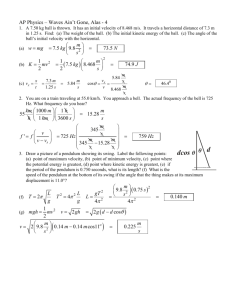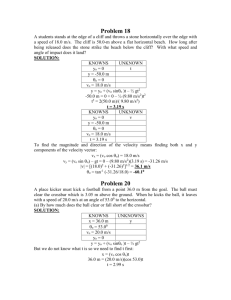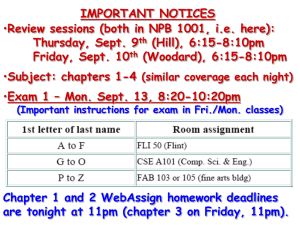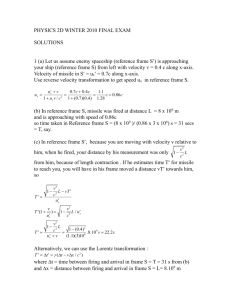Projectile Motion 0.5
advertisement
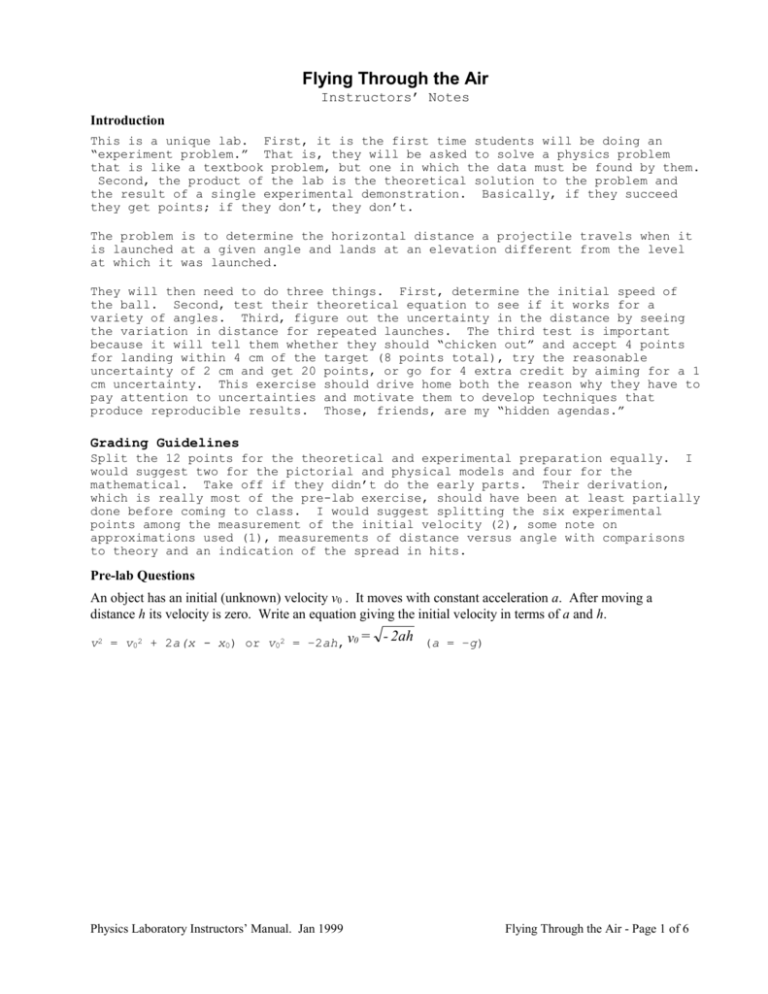
Flying Through the Air Instructors’ Notes Introduction This is a unique lab. First, it is the first time students will be doing an “experiment problem.” That is, they will be asked to solve a physics problem that is like a textbook problem, but one in which the data must be found by them. Second, the product of the lab is the theoretical solution to the problem and the result of a single experimental demonstration. Basically, if they succeed they get points; if they don’t, they don’t. The problem is to determine the horizontal distance a projectile travels when it is launched at a given angle and lands at an elevation different from the level at which it was launched. They will then need to do three things. First, determine the initial speed of the ball. Second, test their theoretical equation to see if it works for a variety of angles. Third, figure out the uncertainty in the distance by seeing the variation in distance for repeated launches. The third test is important because it will tell them whether they should “chicken out” and accept 4 points for landing within 4 cm of the target (8 points total), try the reasonable uncertainty of 2 cm and get 20 points, or go for 4 extra credit by aiming for a 1 cm uncertainty. This exercise should drive home both the reason why they have to pay attention to uncertainties and motivate them to develop techniques that produce reproducible results. Those, friends, are my “hidden agendas.” Grading Guidelines Split the 12 points for the theoretical and experimental preparation equally. I would suggest two for the pictorial and physical models and four for the mathematical. Take off if they didn’t do the early parts. Their derivation, which is really most of the pre-lab exercise, should have been at least partially done before coming to class. I would suggest splitting the six experimental points among the measurement of the initial velocity (2), some note on approximations used (1), measurements of distance versus angle with comparisons to theory and an indication of the spread in hits. Pre-lab Questions An object has an initial (unknown) velocity v0 . It moves with constant acceleration a. After moving a distance h its velocity is zero. Write an equation giving the initial velocity in terms of a and h. v2 = v02 + 2a(x - x0) or v02 = –2ah, v0 Physics Laboratory Instructors’ Manual. Jan 1999 = - 2ah (a = –g) Flying Through the Air - Page 1 of 6 Do the Theoretical Analysis on page 3. First, do the pictorial and physical models. Here is a step-by-step approach to the mathematical model. Strategy Horizontal (x) Vertical (y) Identify the initial position x0 = 0 y0 = h Resolve initial velocity v0 at θ0 into x- and y-components vx0 = v0 cos θ0 vy0 = Using your coordinate system, identify components of acceleration. ax = 0 ay = –g Specialize generic equation x = x0 + v0 t + ½ at2 for x- and y-directions x = v0 cos θ0 t y = h+v0 sin θ0t – ½gt2 Identify location where projectile lands x=L y=0 Find time when it lands in terms of L and vx0 and substitute into equation for y. t =L/v0 cos θ0 0 = h +v0sinθ0L/v0cosθ0 – Equation for y position is now a quadratic equation involving L. Solve it for L. Your equation will involve g, h, L, v0, tan θ0, and cos θ0. Physics Laboratory Manual. Sept. 1995 v0 sin θ0 ½g(L/v0 cos θ0)2 0 = – h –tan θ0L + (g/2v02 cos2θ0)L2 L= v0 cos 2 2 v0 sin + v0 sin + 2gh g Introduction to the Physics Laboratory - Page 2 of 8 Theoretical Analysis A projectile is launched at a given speed, v0, and angle, θ0, from a height h > 0 above the ground. It lands on the ground a horizontal distance L from the launching point. Determine an expression for the distance L in terms of the initial height, speed, and angle. Pictorial Model · · · · · Draw coordinate axes. Sketch the motion. Identify x and y components of quantities at key positions during the motion. Start: x0=0, y0 = h. List known constants. a = -g = -9.80 m/s2 Identify unknowns that need to be determined. v0 v0x = v0 cos θ0, v0y = v0 sin θ0 Physics Laboratory Manual. Sept. 1995 End: x = L, y = 0 Introduction to the Physics Laboratory - Page 3 of 8

